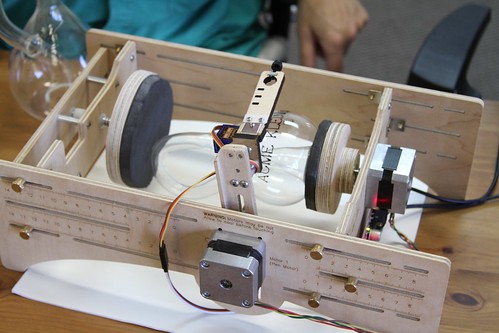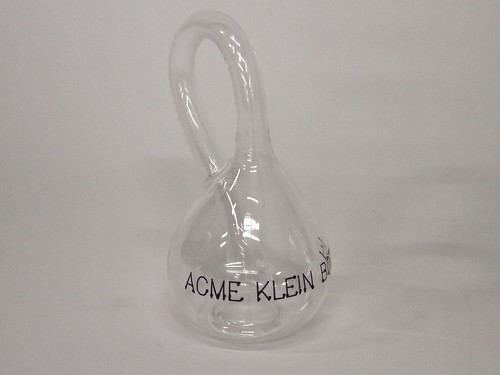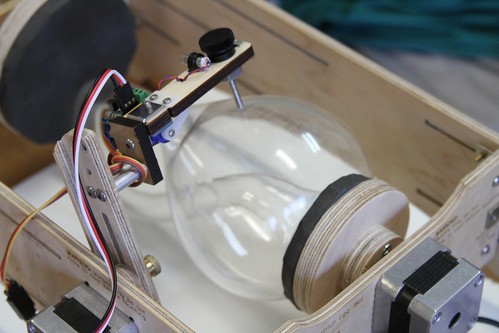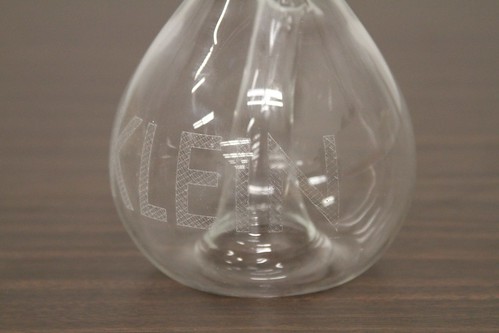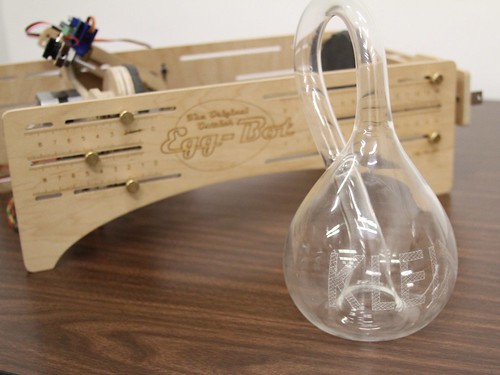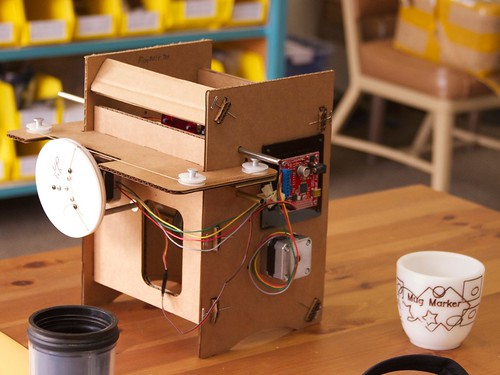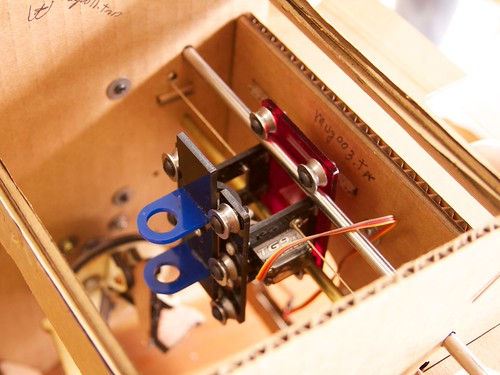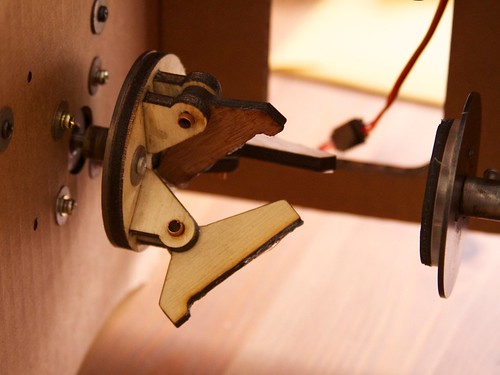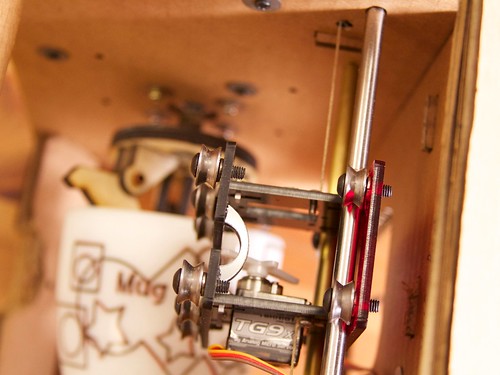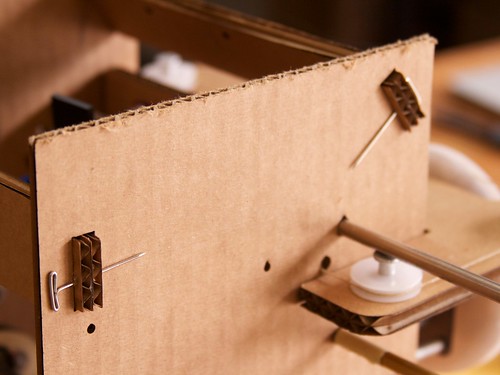This Friday, September 6, we’ll be at the 2013 Open Hardware Summit at MIT. The schedule looks great, and the event is now sold out. Those of you lucky enough to get tickets will love this years e-badge by WyoLum, featuring a programmable e-paper display.
Category Archives: Open Hardware
A few seconds of Octolively on vine
Alex Ray (@machinaut) has been playing with our Octolively open source interactive LED kits and says, “Physical computing interfaces are fun.”
Three Little Upgrades to the WaterColorBot
Even while the Kickstarter campaign for our WaterColorBot is in full swing, we’re continuing to improve its hardware design. Here are a select few of the refinements we have made since the last revision that will make the WaterColorBot better for everyone.
Open Medical Hardware: The Open Stent
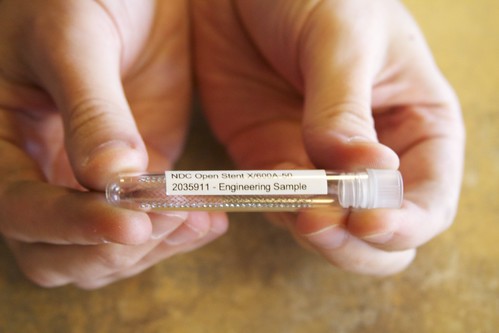
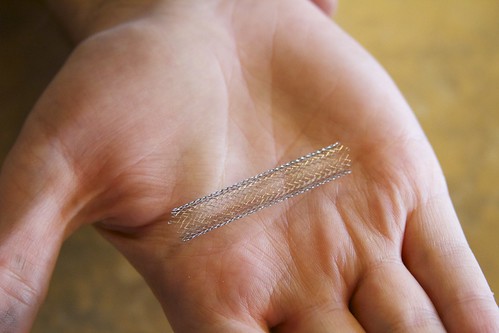
The stent pictured above is an example of an Open Stent from NDC, makers of nitinol materials and devices, particularly for medical applications. In their introduction to the project, they write:
The first problem that we encounter when developing useful and practical educational resources for stent design is that every design we might want to use as an example is proprietary! That leaves us without much to talk about… So to solve this problem, the first step was to create a design to use as an example. The Open Stent is designed to be completely generic, but also realistic, and relatively easy to modify and extend to be useful for whatever purpose a designer intends.
In addition to publishing their draft of Open Stent Design, which they call “a practical guide and resource for design and analysis of a generic Nitinol stent,” NDC has provided extensive calculation tools and CAD files as well, to help others evaluate and create derivatives of the design.
The project is a fascinating open source hardware use case, where creating an open design provides a platform for education and discussion where none existed before. It’s also very exciting to recognize this as an early example of open source hardware in the field of medical devices— one of the places where open hardware can potentially make a very big difference in the world.
Marking Klein Bottles with the Eggbot
We were lucky enough to have a visit from Cliff Stoll, geek celebrity and proprietor of Acme Klein Bottle. Acme is the finest source of Klein bottles on the internet.
Cliff came with an esoteric dilemma: how to engrave a glass Klein bottle. Acme Klein bottles are blown from borosilicate (Pyrex) glass, which has a low coefficient of thermal expansion, which means that the usual way of engraving a curved glass surface—laser engraving—doesn’t actually work. With more common types of glass, you can use a laser engraver to etch anything you want into the surface. But with Pyrex, the surface simply melts unevenly rather than creating the microfractures that give an etched appearance.
So how would you etch the curved surface of a Klein bottle? It turns out, to our surprise, that it is remarkably easy to do it with an Ostrich Eggbot fitted with a diamond engraver attachment.
There was one complication, which is that a Klein bottle is a funny shaped object! In order to fixture the Klein bottle in the Eggbot, we made a couple of extra large couplers—much larger than the tiny pads normally used to hold the ends of an egg—with EVA foam rubber pads on their surfaces. The extra large couplers held the Klein bottle securely for rotation.
We did some initial tests with Sharpie and a medium sized Klein bottle to make sure our fixturing worked well.
And then we hooked up an engraver for a real test.
Here’s what the Klein bottle looked like after engraving. Not being particularly creative, we etched the word “KLEIN” into the side. Because the Klein bottle is made from thick borosilicate glass, it takes engraving remarkably well. It is a much more sturdy object than the fragile Christmas ornaments that we have engraved in the past.
While we can’t imagine that it is a major market segment, the Eggbot seems to be ideal for working with Klein bottles (insomuch as anything can be perfect for working with a closed, non-orientable, boundary-free manifold). But regardless, it’s quite wonderful to find an unexpected application like this, where our little robot can solve a real-world problem that we had never even considered.
The Mug Marker
Don McRae recently stopped by our shop last week to show off his homebrew CNC project, the “Mug Marker” — a wonderful little cardboard robot that can draw on mugs.
Much like the Mug Plotter on Instructables, it uses the same EBB controller board and stepper motors as the Eggbot, but with linear motion for the pen instead of rotation. However, unlike that version, Don has incorporated the same winch-drive mechanism that we use on the WaterColorBot to provide motion for the linear axis– meaning that it can go fast or slow, with very good accuracy.
Don laser cut the large white winch on the back of the machine from acrylic. It controls a string that pulls the pen carriage back and forth as it rides on a pair of rods:
The pen holder itself slides into some additional bearings, and has a small protrusion on the back that rests on the servo horn, allowing it to be lifted up or lowered down. Like the Eggbot’s pen-lift mechanism, this mechanism only (actively) lifts the pen, which means that it can ride over uneven surfaces, or plot on mugs with variable diameter.
Underneath the pen carriage, the opening of the mug fits onto a three-jaw coupler on the motor shaft, and the base of the mug is held against a rubber faced spring loaded plunger. Small copper tubes are used as bushings to allow the coupler pieces to rotate inward or outward to allow mugs of differing diameters to fit on. A little silicone on the surface of each of the three parts provides a gripping surface, and the upcurved lip keeps the mug from sliding too far.
Looking down through the pen carriage, you can see the mug below held in the coupler.
The chassis of the machine is made from cardboard, either hand or laser cut to slot together, and held together very cleverly with pins. The whole machine is put together from a combination of off the shelf parts and found materials, many of which are laser cut for the correct shape. For software, Don uses the Eggbot Inkscape extensions with very reproducible results.
Thanks to Don for bringing it by and letting us take pictures!
Introducing The WaterColorBot
Today we’re thrilled to be launching our newest kit: the WaterColorBot.
The WaterColorBot is a brand-new project from Evil Mad Scientist Laboratories and Super Awesome Sylvia — a friendly art robot that moves a paint brush to paint your digital artwork onto paper, using a set of watercolor paints.
We’ve previously written about how we got started on this project (in a guest post by Sylvia), and about Sylvia’s visit to the White House Science Fair, where she was able to give President Obama a personal demonstration of the WaterColorBot.
And now, you can get one too! We’re launching the WaterColorBot today on Kickstarter, and we’d like to ask for your support in getting it out there. The WaterColorBot is an enormously powerful tool for helping to get young people interested in technology:
Beyond simple fun, we think that the WaterColorBot has enormous potential for STEM and STEAM education, especially as a way to get young people engaged with hands-on technology and robotics. We are particularly interested finding ways to inspire young women to pursue careers in science and technology. We cannot imagine any better way to do so, than starting with a robot co-designed by a 12 year old girl.
Perhaps more than anything else that we’ve done, we think that the WaterColorBot really can make the world a better place, one (young) Evil Mad Scientist at a time.
PCBmodE: Make your PCB a work of art

The folks at BoldPort have created PCBmodE, free open source software for designing printed circuit boards, but with an artistic perspective. Traditional EDA tools are designed from an engineering perspective, whereas PCBmodE treats the PCB as a creative palette. They aim to give you freedom to express your design with all the tools of the medium.
We wanted to create circuit boards that have curvey traces, meandering paths, and multiple soldermask layers, so we developed PCBmodE (say “PCB mode”), an open source Python software that unshackle us from the constraints imposed by traditional PCB design tools. We use the power of Inkscape — the leading open source vector graphics editor — to achieve any shape imaginable. Together with our powerful back-end tools, we can manufacturable beautifully functional boards.
They’ve posted about several of their example boards including pieceof (pictured above), a Raspberry Pi daughterboard called shimmy, and a tribute board dedicated to Bob Pease. This is a really neat approach to building circuit boards, and it looks like it has a lot of potential.
The 2013 Open Hardware Summit: Call for Papers Extended
Good news if you’re still working on— or haven’t yet started —your proposal for this year’s Open Hardware Summit: The call for papers has been extended, so you’ve got another week to fine tune your talk, poster, or demo proposal.
Submissions are now due by JUNE 28, 2013.
The Open Hardware Summit is the world’s first comprehensive conference on open hardware; a venue to discuss and draw attention to the rapidly growing Open Source Hardware movement. This year’s summit takes place on September 6 at MIT.
Previously: The 2013 Open Hardware Summit: Call for Papers,
The 2013 Open Hardware Summit: Tickets Now Available
Photo credit: Open Hardware Summit on Flickr.
gEDA footprints for the OSHW Logo
Open Source advocate Russ Nelson wrote in to tell us about gEDA footprints (circuit board elements) for the Open Source Hardware Logo, available to browse and download at gedasymbols.org. Russ created these footprints to make a version of our earlier examples that would be easier to use.
gEDA is the open source (GPL licensed) Electronic Design Automation suite, which we use to design all of our circuit boards. gEDA now runs well on Mac, Windows, and Linux. If you’d like to try it out, you may want to begin with our own list of resources for getting started with gEDA, available here. And, if you produce open source hardware, you might find these footprints handy.








